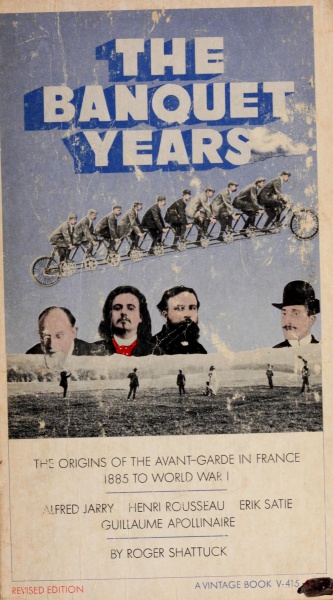Julia Vaingurt: Wonderlands of the Avant-Garde: Technology and the Arts in Russia of the 1920s (2013)
Filed under book | Tags: · 1920s, aesthetics, architecture, art, art history, avant-garde, biomechanics, body, cinema, communism, constructivism, design, literature, machine, politics, russia, science fiction, sexuality, socialism, soviet union, technē, technology, theatre

“In postrevolutionary Russia, as the Soviet government was initiating a program of rapid industrialization, avant-garde artists declared their intent to serve the nascent state and to transform life in accordance with their aesthetic designs. In spite of their professed utilitarianism, however, most avant-gardists created works that can hardly be regarded as practical instruments of societal transformation. Exploring this paradox, Vaingurt claims that the artists’ investment of technology with aesthetics prevented their creations from being fully conscripted into the arsenal of political hegemony. The purposes of avant-garde technologies, she contends, are contemplative rather than constructive. Looking at Meyerhold’s theater, Tatlin’s and Khlebnikov’s architectural designs, Mayakovsky’s writings, and other works from the period, Vaingurt offers an innovative reading of an exceptionally complex moment in the formation of Soviet culture.”
Publisher Northwestern University Press, 2013
SRLT series
ISBN 0810128942, 9780810128941
322 pages
via Sorin
Review: Boris Dralyuk (NEP, 2013), Tim Harte (Slavic Review, 2014).
PDF (updated on 2022-11-12)
See also the science-fiction film Aelita, Queen of Mars, dir. Yakov Protazanov, 1924, 111 min, based on Tolstoy’s novel.
Comments (2)Speculations V: Aesthetics in the 21st Century (2014)
Filed under journal | Tags: · aesthetics, art, avant-garde, literature, philosophy, speculative realism, theory

“Ever since the turn of the century aesthetics has steadily gained momentum as a central field of study across the disciplines. No longer sidelined, aesthetics has grown in confidence. While this recent development brings with it a return to the work of the canonical authors (most notably Baumgarten and Kant), some contemporary scholars reject the traditional focus on epistemology and theorize aesthetics in its ontological connotations. It is according to this shift that speculative realists have proclaimed aesthetics as “first philosophy” and as speculative in nature. With speculative realism aesthetics no longer necessarily implies human agents. This is in alignment with the general speculative realist framework for thinking all kinds of processes, entities, and objects as free from our allpervasive anthropocentrism which states, always, that everything is “for us.”
This special issue of Speculations: A Journal of Speculative Realism explores the ramifications of what could be termed the new speculative aesthetics. In doing so, it stages a three-fold encounter: between aesthetics and speculation, between speculative realism and its (possible) precursors, and between speculative realism and art and literature.”
With contributions by Steven Shaviro, Theodor Leiber and Kirsten Voigt Sellars, Matija Jelača, Claire Colebrook, N. Katherine Hayles, Jon Cogburn and Mark Allan Ohm, Miguel Penas López, Graham Harman, Bettina Funcke, Thomas Gokey, Robert Jackson, Roberto Simanowski, Francis Halsall, Magdalena Wisniowska Disegno, and Sjoerd van Tuinen.
Edited by Ridvan Askin, Paul J Ennis, Andreas Hägler, and Philip Schweighauser
Publisher punctum books, Brooklyn, NY, May 2014
Creative Commons License BY-NC-SA
ISBN 0692203168, 9780692203163
ISSN 2327-803X
474 pages
PDF (single PDF, 9 MB, updated on 2016-12-24)
PDFs (individual essays, updated on 2016-12-24)
Roger Shattuck: The Banquet Years: The Origins of the Avant-Garde in France, 1885 to World War I., Rev. ed. (1955/1968)
Filed under book | Tags: · 1880s, 1890s, 1900s, 1910s, absurd, anarchism, art, art history, avant-garde, cubism, dada, dreams, france, literature, logic, montage, music history, painting, pataphysics, poetry, theatre, typography

In this book Roger Shattuck portrays the cultural bohemia of turn-of-the-century Paris who carried the arts into a period of renewal and accomplishment, and laid the ground-work for Dada and Surrealism.
“…Then came the idea–a kind of gambler’s hunch–that the trio Rousseau-Satie-Apollinaire represented several significant aspects of the period and could reveal them better than any single figure. The idea would not die. [..] Jarry had forced his way into the group and established himself close to the center of things. He helped clarify my underlying subject: how the fluid state known as bohemia, a cultural underground smacking of failure and fraud, crystallized for a few decades into a self-conscious avant-garde that carried the arts into a period of astonishingly varied renewal and accomplishment. [..] An enormous amount has been written on this era and these men since the first edition of this book in 1958. I have taken account of some of it by changing those passages where new facts have come to light.” (from the Preface to this edition)
First published in 1955
Publisher Vintage Books, 1968
397 pages
Review (Alfred Kazin, The Reporter, 1958)
Review (Sidney Tillim, College Art Journal, 1959)
Review (Justin O’Brien, The Saturday Review, 1958)
PDF (115 MB, no OCR)
Comment (0)
